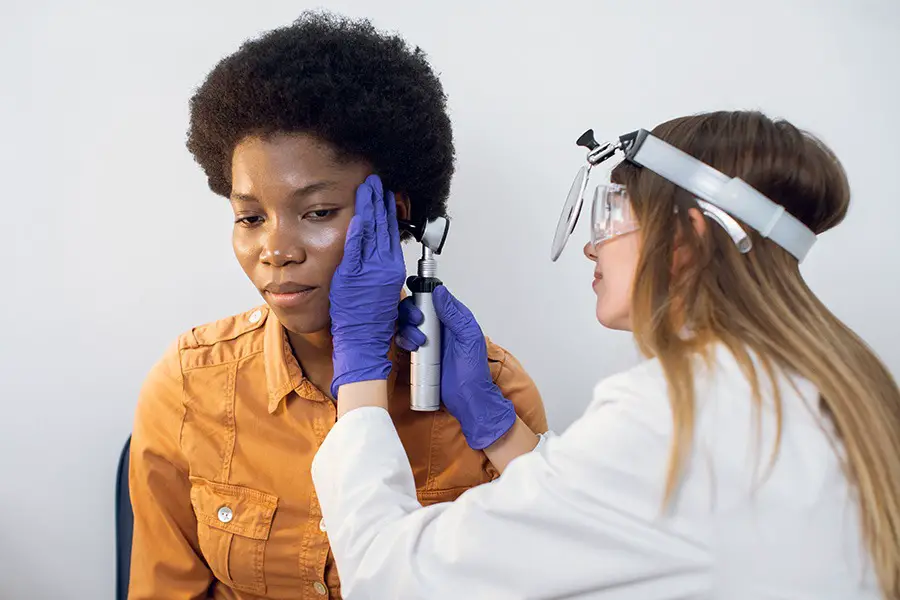Introduction
We live in a noisy world, where we are constantly exposed to sounds that can harm our hearing. Some of us can escape this noise pollution, but what about those who face a different kind of silence? A silence that is not peaceful, but lonely and frightening. This silence is often the reality of people with sensorineural hearing loss. Despite the advances in medical science, sensorineural hearing loss – aka SNL – remains a major challenge, especially for the elderly population.
This condition, caused by damage to the hair cells in the cochlea or to the nerve pathways from the inner ear to the brain, is the most common type of permanent hearing loss. As we explore this topic, we aim to highlight various aspects of this issue. Let’s learn about the severity of sensorineural hearing loss in the elderly, its profound impact on specific communities such as veterans and musicians, and strategies for managing it in the workplace.
The purpose of this article is not to scare you but to inspire you. We hope to empower those who have sensorineural hearing loss and provide useful insights for their family, friends, and employers to support them better. Together, let’s break the silence and create a world that is more inclusive, empathetic, and harmonious for all.
Remember, losing your hearing does not mean losing your voice or your ability to enjoy life. Let’s move forward with this spirit and discover the realm of sensorineural hearing loss.
The Promise of Gene Therapy in Sensorineural Hearing Loss
Gene therapy is emerging as a revolutionary approach to treating SNL. Through the manipulation of genes within the inner ear cells, scientists aim to restore or preserve hearing. An example of this approach is the use of vectors, like harmless viruses, to deliver therapeutic genes to the damaged cells.
Consider the story of Robert, a senior with progressive SNL. Robert participated in a clinical trial investigating a gene therapy technique to slow the progression of his hearing loss. The treatment aimed to replace the defective genes in his inner ear cells with healthy copies. The results were promising, providing Robert with an improved sense of hearing and an enhanced quality of life.
Advancements in Surgical Treatments for Sensorineural Hearing Loss
While hearing aids and cochlear implants have long been part of the arsenal against sensorineural hearing loss, surgical treatments have evolved to offer more options. New techniques aim to restore natural hearing by directly addressing the root causes of the condition, such as damage to the inner ear cells.
Linda, a senior living with SNL, underwent a groundbreaking surgical procedure. The surgery involved the implantation of a tiny device in her cochlea, designed to stimulate her auditory nerve directly. Post-surgery, Linda experienced a remarkable improvement in her hearing abilities, reiterating the potential of advanced surgical treatments.
Stem Cells and Sensorineural Hearing Loss The Potential for Regeneration
Stem cell research is providing a ray of hope in the world of sensorineural hearing loss. With their ability to differentiate into a variety of cell types, stem cells carry the potential to regenerate damaged hair cells in the inner ear, a key factor in sensorineural hearing loss.
James, a senior who had experienced SNL for several years, decided to participate in a study focusing on stem cell therapy. This research aimed to implant stem cells into the cochlea, intending to regenerate the lost hair cells. The results were encouraging, as James reported an improvement in his hearing capabilities, emphasizing the potential of stem cell therapy.
The Role of Neuroplasticity in Sensorineural Hearing Loss Research
Neuroplasticity, the brain’s ability to change and adapt, is a compelling area of research in understanding and managing sensorineural hearing loss. Scientists are exploring how the brain can be trained to compensate for the hearing loss by enhancing its ability to process sound signals.
Let’s consider Susan, who has lived with SNL for years. She joined a research study that employed neuroplasticity-based techniques, such as auditory training exercises, to improve her hearing. The program helped Susan refine her ability to recognize and interpret sounds, demonstrating the promising role neuroplasticity plays in managing sensorineural hearing loss.
Exploring the Link Between Hormones and Sensorineural Hearing Loss
Recent research suggests a potential link between hormonal changes and sensorineural hearing loss. Hormones such as estrogen and progesterone are believed to play a protective role in hearing, and imbalances may contribute to hearing loss.
Grace, a postmenopausal woman with SNL, participated in a study examining the effects of hormone replacement therapy (HRT) on hearing loss. The research is still ongoing, but the potential link offers an exciting avenue for future treatment options.
Conclusion
The landscape of sensorineural hearing loss, as we’ve seen, is not just a chronicle of struggles but a saga of continuous discovery and innovation. Through the promising realms of gene therapy, advanced surgical treatments, stem cell research, neuroplasticity, and hormonal influences, we glimpse a future filled with optimism and potential.
Every story we’ve shared, every person we’ve introduced, and every breakthrough we’ve explored is a testament to the resilience of the human spirit, the ingenuity of the human mind, and the relentless pursuit of a world where sensorineural hearing loss no longer limits the melody of life.
So, for our seniors and their loved ones living with sensorineural hearing loss, remember that this journey does not tread upon the path of solitude. It is a voyage shared with brilliant scientists, empathetic caregivers, and a society gradually awakening to the symphony of inclusivity and understanding.
With every sunset, there dawns a new day of scientific breakthroughs and innovative therapies. Let’s keep hope alive, for we are on the precipice of transformation, on the brink of turning the silence of sensorineural hearing loss into a crescendo of sounds, reconnecting our seniors to the beautiful symphony of life.

Decoding Silence: An Analytical View on the Advances in Conductive Hearing Loss Research and Treatment
This analytical article sheds light on conductive hearing loss, offering an in-depth exploration of its genetic factors, treatment advances, and promising experimental therapies.

Embracing the Melody of Life: Navigating the Journey with Conductive Hearing Loss
A blog post delving into the experiences and challenges of living with conductive hearing loss, discussing its impact on everyday life, social interactions, mental health, and the potential benefits of hearing aids and cochlear implants.





